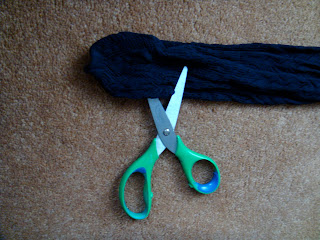
A few months ago I was fortunate enough to find this vintage Balenciaga scarf for a shockingly low price (given his preeminent stature in fashion history). So it goes with so many vintage accessories: scarves bearing the names of great fashion houses sit around gathering dust while the (frankly less wearable) suits and dresses by the very same masters are snapped up by museums and wealthy collectors.

I don't get it, but that doesn't mean I don't profit by it. This scarf is particularly emblematic because it bears one of the hallmarks of Balenciaga's designs round about 1960--a fuschia pink bow, which appeared again and again as a flourish on his dresses and ballgowns. The bow dominates the cream ground, surrounded by a border of broken pink brushstrokes. (The design itself looks as if it might be by the hand of fashion illustrator René Gruau, who frequently collaborated with Balenciaga). The edges of the scarf are raw, which is typical of those from this house. Another point to note: Balenciaga scarves were sold only in his shops in Madrid, Barcelona, and Paris, and it's nice to think that at some point his own eyes might have glanced at this object.
I became slightly obsessed by the idea of wearing this scarf in a way that would accord with the designer's stringent eye. This meant combing the internet for images of late 50s/early 60s Balenciaga ensembles that included a scarf--and guess what, none did. I believe this is because during that period, a scarf, even of gorgeous heavy silk, fell more into the category of sportswear than city dress: worn to mainstay the coiffure on the beach or while horseback riding or driving along the coast in a convertible.
But then Myra Walker's wonderful book
Balenciaga and his Legacy came to the rescue, with this photo of what I originally took to be a hat. But it's not, or not entirely--it's a low pillbox, more like a skullcap, that has been artfully trussed with a scarf of approximately the same vintage as mine.

I could do this, and you can too, given just such a molded hat and a beautiful silk scarf. Here's how:
1) halve the scarf into a triangle and set the broad end at the front of the cap.
2) loop the ends in back and knot several times
3) if the scarf has a signature that you'd like to show, foof around with the ends until it's on display as desired.
Of course you could leave out the cap and simply tie the scarf on your head without it, but if you want the sculptural quality that marked Balenciaga's work, do go for some armature underneath.

Cristóbal Balenciaga cocktail dress at top, 1958 (Photo courtesy of the Museum at FIT). Balenciaga hat, c. 1960, in
Balenciaga and His Legacy, Myra Walker, 2006.











































